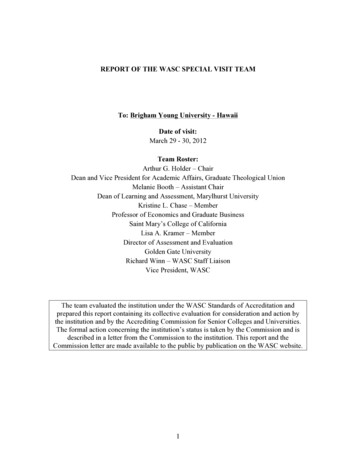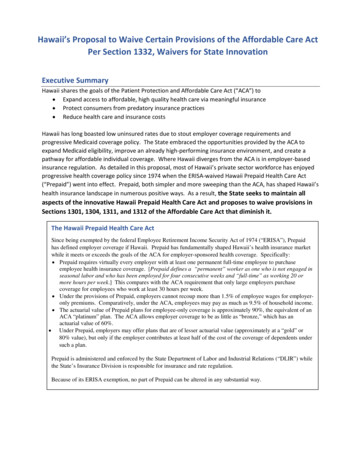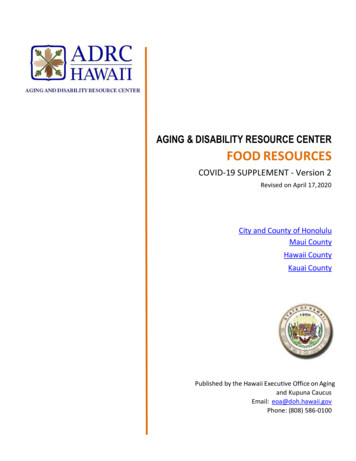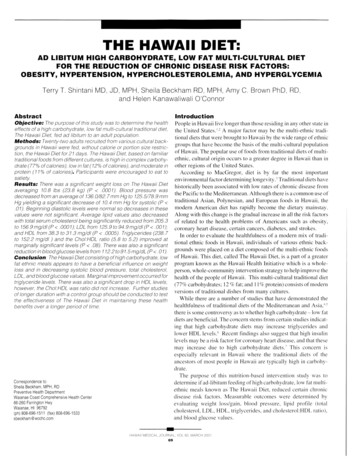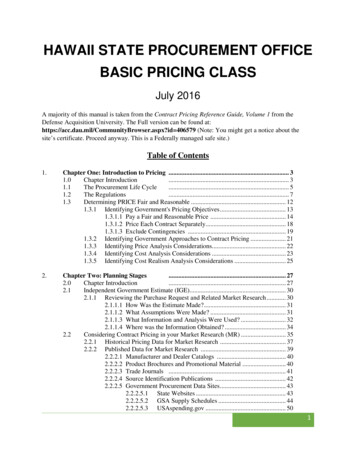
Transcription
HAWAII STATE PROCUREMENT OFFICEBASIC PRICING CLASSJuly 2016A majority of this manual is taken from the Contract Pricing Reference Guide, Volume 1 from theDefense Acquisition University. The Full version can be found at:https://acc.dau.mil/CommunityBrowser.aspx?id 406579 (Note: You might get a notice about thesite’s certificate. Proceed anyway. This is a Federally managed safe site.)Table of Contents1.Chapter One: Introduction to Pricing . 31.0Chapter Introduction. 31.1The Procurement Life Cycle. 51.2The Regulations. 71.3Determining PRICE Fair and Reasonable . 121.3.1 Identifying Government's Pricing Objectives . 131.3.1.1 Pay a Fair and Reasonable Price . 141.3.1.2 Price Each Contract Separately. 181.3.1.3 Exclude Contingencies . 191.3.2 Identifying Government Approaches to Contract Pricing . 211.3.3 Identifying Price Analysis Considerations. 221.3.4 Identifying Cost Analysis Considerations . 231.3.5 Identifying Cost Realism Analysis Considerations . 252.Chapter Two: Planning Stages. 272.0Chapter Introduction. 272.1Independent Government Estimate (IGE). 302.1.1 Reviewing the Purchase Request and Related Market Research . 302.1.1.1 How Was the Estimate Made? . 312.1.1.2 What Assumptions Were Made? . 312.1.1.3 What Information and Analysis Were Used? . 322.1.1.4 Where was the Information Obtained? . 342.2Considering Contract Pricing in your Market Research (MR) . 352.2.1 Historical Pricing Data for Market Research . 372.2.2 Published Data for Market Research . 392.2.2.1 Manufacturer and Dealer Catalogs . 402.2.2.2 Product Brochures and Promotional Material . 402.2.2.3 Trade Journals . 412.2.2.4 Source Identification Publications . 422.2.2.5 Government Procurement Data Sites . 432.2.2.5.1 State Websites . 432.2.2.5.2 GSA Supply Schedules . 442.2.2.5.3 USAspending.gov . 501
2.32.42.2.2.5.4 Dynamic Small Business Search . 532.2.2.2.5 Federal Business Opportunities. 542.2.2.6 Government Economic Data . 552.2.2.7 Non-Government Economic Data . 592.2.3 Market Research Data from Prospective Offerors . 622.2.4 Market Research Data from Other Sources . 64Using Market Research to Estimate Probable Price . 642.3.1 Evaluating Your Market Research . 652.3.2 Developing Your Price Estimate . 66Developing Your Procurement Strategy . 672.4.1 Identifying Procurement Team Members . 682.4.2 Life Cycle Costs. 712.4.2.1 Lease Vs. Purchase Factors . 743.Chapter Three: Solicitation & Award . 783.1Responsibility. 783.2Price Analysis. 803.2.1 Comparisons in Price Analysis . 803.2.2 Considering Contract Pricing . 823.2.3 Price Analysis Process . 833.2.4 Selecting Prices for Comparison. 873.2.4.1Other Proposed Prices . 893.2.4.2Commercial Prices . 903.2.4.3Previously-Proposed Prices and Contract Prices . 923.2.4.4Parametric and Rough Yardsticks Estimates . 933.2.4.5Independent Government Estimates (IGE) . 943.3Identifying Factors That Affect Comparability . 973.4Determining The Effect of Identified Factors . 1013.5Adjusting The Prices Selected for Comparison . 1033.6Comparing Adjusted Prices. 1043.7Unbalanced Bids. 1073.8Price-Related Decision Process . 1093.9Establish Pre-Negotiation Price Positions . 1093.9.1 Analyze Risk. 1103.9.2 Develop Negotiation Positions . 1103.10Identifying Documentation Requirements . 1124.Chapter Four: Contract Management & Closeout/Handover. 1174.1Recognize Special Considerations for Equitable Adjustments . 1184.2Burn Rate & Obligation Logs . 1234.3Closeout – Termination Settlements . 1262
CHAPTER ONE: INTRODUCTION TO PRICING1.0Chapter IntroductionContract Pricing Environment. An important part of your job as a procurement specialist is toconduct the price analyses necessary to ensure that the Government 1 purchases supplies andservices from responsible sources at fair and reasonable prices. To begin your study of contractpricing, we will examine the pricing environment, including: 1Procurement Life Cycle (Section 1.1)The Regulations (Section 1.2)What is Fair and Reasonable Pricing? (Section 1.3)Planning (Chapter 2)o Independent Government Estimate (IGE) (Section 2.1)o Market Research (MR) (Section 2.2)o Strategy (Section 2.3)Solicitation & Award (Chapter 3)o Price Analysis (Section 3.2)The word ‘Government’ is synonymous to State, County and Public Agencies3
Contract Management & Closeout/Handover (Chapter 4)o Request for Equitable Adjustment (Section 4.1)o Burn Rate & Obligation Logs (Section 4.2)o Closeout issues (Section 4.3)Scope of the Training. This Basic class introduces the concept of pricing analysis, and when andhow to do it across the Procurement Life Cycle. It also presents an in-depth study of PriceAnalysis. Multiple tools, templates and recommended websites are included to give you activetools to assist. This training will NOT include any in-depth study on Cost Analysis or CostRealism. These will be presented at a later, Intermediate training.Although the structure of this training is based on Code from HRS103D, Goods, Services andConstruction, all these best practices should be used as practicable for HRS103F, Health andHuman Services as well.4
1.1The Procurement Life CycleCost and pricing requirements do not stand in a vacuum. Rather, they are part of the largerprocurement system called the Procurement Life Cycle. The Procurement Life Cycle denotes aholistic view of the entire procurement process, from inception of the need to procure to thecompletion of that need, or the handover to a continued need and a new procurement. Thus theLife cycle is circular.For our purposes, the Procurement Life Cycle has five major steps:1.2.3.4.5.Procurement PlanningMarket ResearchSolicitation and AwardContract ManagementCompletion & CloseoutAlthough procurement planning and market research should happen in parallel, they are bothsuch important areas to consider, each with substantial data of their own, that it substantiatestheir own Steps. The same could be said about contract management and closeout.5
Cost and Pricing analysis is required in various steps throughout the Procurement Life Cycle. Itis fair to say that a Professional Procurement Officer/Specialist must be considering the effects ofcosts throughout the life of a procurement. Being able to analyze and evaluate pricing, costs,realism, maintain burn rates and log payments and obligations are a vital part of the job.6
1.2The RegulationsStatuteThe Procurement Code talks to the requirement for price and cost certification and analysis. TheHawaii Revised Statute, HRS 103D-312 was recently amended 2 and states:103D-312 Fair and reasonable pricing policy; cost or pricing data.(a)2A procurement officer shall purchase goods, services, and construction from responsiblesources at fair and reasonable prices. A procurement officer shall make a writtendetermination whether a price is fair and reasonable for, each contracting action,including change orders and contract modifications that adjust prices: In establishingwhether a price is fair and reasonable, the procurement officer shall obtain:(1)Certified cost or pricing data for every contract to which subsection (c) applies;and(2)Other data as necessary to perform a cost or price analysis of the data anddetermine a fair and reasonable price, regardless of whether subsection (c) appliesto the contract.Legislative Session 2016, HB 2060 HD1, SD27
(b)The policy board may adopt rules, pursuant to chapter 91, to establish an order ofpreference in the type of data required under subsection (a)(2).(c)A contractor, except as provided in subsection (e), shall submit cost or pricing data andshall certify that, to the best of the contractor's knowledge and belief, the cost or pricingdata submitted is accurate, complete, and current as of a mutually determined specifieddate before the date of:(1)The pricing of any contract awarded by competitive sealed proposals or pursuantto the sole source procurement authority, where the total contract amount isexpected to exceed an amount established by rules adopted by the policy board; or(2)The pricing of any change order or contract modification that is expected toexceed an amount established by rules adopted by the policy board. Therequirement of this paragraph shall apply regardless of whether the originalcontract award did not require certified cost and pricing data.(d)Any contract, change order, or contract modification under which a certificate is requiredshall contain a provision that the price to the State, including profit fee, shall be adjustedto exclude any significant sums by which the State finds that the price was increasedbecause the contractor furnished cost or pricing data that was inaccurate, incomplete, ornot current as of the date agreed upon between the parties.(e)The requirements of this section, except for the requirements of paragraph (c) (2), shallnot apply to original contract awards:(1)Where the original contract price is based on adequate price competition;(2)Where the original contract price is based on established catalog prices or marketprices;(3)Where the original contract prices are set by law or rule; or(4) Where it is determined in writing in accordance with rules adopted by the policyboard that the requirements of this section may be waived, and the reasons for thewaiver are stated in writing; - provided that the requirements for price and costinqdata required under subsection (a) (2) shall not be waived without the approval of thechief procurement officer; provided further that the chief procurement officer shallnot delegate this authority.”8
RulesHawaii Administrative Rules (HARS) Subchapter 15, 3-122-121 through 130 supplements theStatute with additional cost and pricing guidance. Here is an excerpt from the Rules:§3-122-123 Requirement for cost or pricing data. The procurement officer shall requirecost or pricing data or both in support of the following, and may require for professionalservices pursuant to subchapter 7:(1)Any contract, resulting from competitive sealed proposals or sole sourceprocurement, expected to exceed 100,000;(2)Any price adjustment to a contract involving aggregate increases and decreases incosts plus applicable profits expected to exceed 100,000, including a contractresulting from competitive sealed bidding, whether or not cost or pricing datawere required in connection with the initial pricing of the contract, except whenunrelated and separately priced adjustments, not requiring cost or pricing data ifconsidered separately, are consolidated for administrative convenience; or(3)A written determination by a procurement officer that the circumstances warrantrequiring submission of cost or pricing data provided, however, when less thancomplete cost analysis, for example; analysis of only specific factors will providea reasonable pricing result on awards under 100,000 without the submission ofcomplete cost or pricing data, the procurement officer shall request only that dataconsidered adequate to support the limited extent of the cost analysis needed andneed not require certification.§3-122-124(a)Exceptions to the requirement for cost or pricing data.Cost or pricing data need not be submitted or certified where the contract price is basedon:(1)Adequate price competition which means at least two responsible offerersindependently compete for a contract to be awarded to the offerer submitting thelowest evaluated price.(2)Established catalogue price which means the price included in a catalogue, pricelist, schedule, or other form that is regularly maintained by a manufacturer orcontractor; is either published or otherwise available for inspection by customers;and states the price at which sales are currently or were last made to a significantnumber of any category of buyers or buyers constituting the general (nongovernment) buying public for the goods or services involved.9
(3)Established market price which means a current price, established in the usual andordinary course of trade between buyers and sellers, which can be substantiatedfrom sources independent of the manufacturer or supplier and may be anindication of the reasonableness of price.(4)Prices set by law or regulation which means the price of a good or service is setby law or rule if some governmental body establishes the price that the contractormay charge the State and other customers.(b)If, despite the existence of an established catalogue price or market price, and afterconsultation with the prospective contractors, the procurement officer considers that theprice is not reasonable, cost or pricing data may be requested. Where the reasonablenessof the price can be assured by a request for cost or pricing data limited to data pertainingto the differences in the item or services being procured and those listed in the catalogueor market, requests should be so limited.(c)When the chief procurement officer or the head of a purchasing agency determines inwriting to waive the applicable requirements of section 3-122- 123 (l) or 3-122 123(2) forsubmission of cost or pricing data in a particular pricing action and the reasons for thewaiver are stated in the determination, a copy of the determination shall be kept in thecontract file and made available to the public upon request.(d)If after cost or pricing data were initially requested and received, it is determined thatadequate price competition does exist, the data need not be certified.10
SPO Form 13 is a template used for Certification of Cost or Pricing Data. (Found at /12/spo-013.pdf )NOTE: Certification is not the end of this process. The Procurement Officer still needs toanalyze the cost or pricing data submitted to find it fair and reasonable!In addition to the above, the HARS also has guidance on Cost Principles in HARS, Chapter 123based on HRS 103D-601 Cost Principles.These Rules show what costs are allowable, appropriate and allocable. Typically, this area ismore predominant in Cost Analysis. However, it is important to have a working knowledge ofwhat costs contractors should not be proposing.11
1.3Determining PRICE Fair and ReasonableDefinitions of Price. From both work and personal business dealings, most people think of priceas the amount of money that a buyer pays a seller for the delivery of a product or theperformance of a service. Price considerations emphasizes its components: Cost plus any fee orprofit applicable to the contract type.Both definitions of price are important. Primarily, price is defined as the amount the buyer paysfor a product or service. However, it is important to remember that, if prices do not coversupplier costs and provide a profit, losses will occur. When a contract is priced below cost,performance risk increases. The contractor must finance contract performance with funds fromother sources (e.g., profits from other contracts, financial reserves, or overpriced contractmodifications). If contractor efforts to control costs result in unsatisfactory performance,contractor default is a real possibility.12
1.3.1Identifying Government's Pricing ObjectivesThis section covers the following topics: 1.3.1.1 - Pay A Fair and Reasonable Price1.3.1.2 - Price Each Contract Separately1.3.1.3 - Exclude ContingenciesGovernment Pricing Objectives. When buying for the Government, your primary pricingobjective for all contact actions is to acquire supplies and services from responsible sources atfair and reasonable prices.13
1.3.1.1Pay A Fair and Reasonable PriceUnderstand Fair and Reasonable. The first element of the Government pricing objectiverequires that contract prices be fair and reasonable.The procurement officer's 3 primary objective in pricing a contract is to balance the contract type,cost, and profit or fee negotiated to achieve a total result -- a price that is fair and reasonable toboth the Government and the contractor. [The contracting officer must consider the terms andconditions (delivery, financing, etc.) of each specific contract in order to determine if theprice for that contract is fair and reasonable.]The term "fair and reasonable price," implies two tests: What is fair?What is reasonable?What Is Fair? Buyers and sellers may have different perceptions on what price is fair.1. Fair to the Buyer. To be fair to the buyer, a price must be in line with (or below) either of thefollowing:3The term Procurement Officer is synonymous with Contracting Officer. This also applies to ProcurementSpecialists and Contract Specialists.14
The fair market value of the contract deliverable (if that can be ascertained through priceanalysis). Expect to pay the fair market value, given the prices of market transactionsbetween informed buyers and sellers under similar competitive market conditions fordeliverables with similar product, quality, and quantity requirements.The (1) total allowable cost of providing the contract deliverable that would have beenincurred by a well-managed, responsible firm using reasonably efficient and economicalmethods of performance plus (2) a reasonable profit.As a buyer, you should consider a price that is TOO HIGH to be unfair. What happens if youagree to a price that is too high? You will not be fulfilling your most basic responsibility as a Government procurementofficer or procurement specialist.You will waste scarce tax-payer funds.Since you are publicly accountable as a State/County employee for your decisions, youmay have to answer to your Agency Head, the Chief Procurement Officer, a Legislativecommittee, or the public at large.2. Fair to the Seller. To be fair to the seller a price must be realistic in terms of the seller'sability to satisfy the terms and conditions of the contract. Risk of Prices Unfair to the Seller. Why should you care if a low offer is unrealistic?Because an unrealistic price puts both parties at risk. The risk to the Government is thatthe firm -- to cut its losses -- might:o Cut corners on product quality;o Deliver late;o Default, forcing a time-consuming re-procurement; oro Refuse to deal with the Government in the future or be forced out of businessentirely.Situations for Special Consideration. Fairness to the seller can be a concern in both competitiveand noncompetitive situations. Below-Cost Prices. Below-cost prices are NOT necessarily unfair to the seller. A bidder,for various reasons, in its business judgment may decide to submit a below-cost bid; sucha bid is not invalid. Whether the awardee can perform the contract at the price offered is amatter of responsibility.On the other hand, be on guard against the practice of buying-in -- submitting offersbelow anticipated costs, expecting to:o Increase the contract amount after award (e.g., through unnecessary orexcessively priced change orders); oro Receive follow-on contracts at artificially high prices to recover losses incurredon the buy-in contract.15
Mistakes. The offered price may be unexpectedly low because the seller has made grossmistakes in estimating costs or is otherwise nonresponsible.The award of a contract to a supplier based on lowest evaluated price alone can be falseeconomy if there is subsequent default, late deliveries, or other unsatisfactoryperformance resulting in additional contractual or administrative costs. While it isimportant that Government purchases be made at the lowest price, this does not requirean award to a supplier solely because that supplier submits the lowest offer. Aprospective contractor must affirmatively demonstrate its responsibility, including, whennecessary, the responsibility of its proposed subcontractors.If a vendor offers a price that is far below other offered prices or your estimate of theprobable price, treat the offer as a potential mistake. Conduct fact-finding to determinewhether the offeror understands the work and can perform at the offered price.Single-Source Procurements. Do NOT force a below-cost price on the offeror even ifyou believe that the offeror has the financial ability to absorb the probable loss. Instead,negotiate a contract of a type and a price that is likely to cover all allowable costs ofperformance, assuming reasonable economy and efficiency, and provide a reasonableprofit. Even your opening position in non-competitive negotiations should NOT be a"below cost" number. Rather, your opening position should be based on a moreoptimistic reading of the potential production improvements, risks, and costs of providingthe contract deliverable than that of the target position on price.What Is Reasonable? A reasonable price is a price that a prudent and competent buyer would bewilling to pay, given available data on: Market Conditions. Economic forces such as supply, demand, general economicconditions, and competition change constantly. Hence, a price that is reasonable todaymay not be reasonable tomorrow.o Supply and Demand. The forces of supply and demand can have a significanteffect on product prices: If demand is constant, decreasing supply usually results in higher prices, whileincreasing supply usually results in lower prices. If supply is constant, decreasing demand usually results in lower prices, whileincreasing demand usually results in higher prices.o General Economic Conditions. General economic conditions affect the prices ofall products, but the effect will NOT be the same for every product. Inflation anddeflation affect the value of the dollar. Boom, recession, and depression affectavailable production capacity.o Competition. When competition does not exist, the forces of supply and demandmay not work effectively. The buyer or seller may have an advantage in thepricing decision process.16
Price-Related Evaluation Factors. A prudent buyer will consider differences in the cost ofacquiring and owning a deliverable that are not covered by the contract price. To consider theseprice-related factors in a competitive procurement, the solicitation must provide for suchconsideration. For example: Direct Costs Not Included in The Contract Price. The solicitation allowed offerors tosubmit offers either for f.o.b. destination or f.o.b. origin. Best practice expects that offerevaluation criteria provide for consideration of the shipping costs from f.o.b. origin pointsto destination, however, consider our geographic dis-location from the mainland andfactor that in.Costs of Ownership Not Included in The Contract Price. Your market researchindicates that several products could satisfy your requirement. However, the productsdiffer substantially in maintenance and repair costs. Offer evaluation criteria shouldprovide for consideration of the related costs to the Government.Applying Judgment to the Determination.Your determination of whether an offer is fair and reasonable is a matter of judgment. There isno simple formula in which you can just plug in a few values and receive a firm answer of fairand reasonable. Determining what is fair and reasonable depends on market conditions, youralternatives for meeting the requirement, price-related factors, and the non-price evaluationfactors that relate to each procurement. It also depends on what price you can negotiate with anofferor.A fair and reasonable price does not require that agreement be reached on every element of cost,nor is it mandatory that the agreed price be within the contracting officer's initial negotiationposition. Taking into consideration the advisory recommendations, reports of contributingspecialists, and the current status of the contractor's purchasing system, the contracting officer isresponsible for exercising the requisite judgment needed to reach a negotiated settlement withthe offeror and is solely responsible for the final price agreement.17
1.3.1.2Price Each Contract SeparatelyThe second element of the Government pricing objective requires that contracts be pricedseparately.Perspective. It is human nature to try to balance one contract against another in terms of financialresults. A seller's position might be that the firm lost money on the last contract; therefore, aneffort should be made to make up for that loss on the next contract.A buyer's position might be that the contractor made too much profit on the last contract;therefore, the next contract should be structured to restrict profit.Government Contracting. While these attitudes may be understandable in a personal sense, theyare not valid in Government contracting.Government contracting is very complex because: Buyers and sellers do not have perfect knowledge of all transactions between a contractorand the Government.The market forces of competition, supply, and demand change.Business conditions change.18
Thus, you must price each contract separately and independently to ensure that all proposedprices are fair and reasonable to all involved parties.1.3.1.3Exclude ContingenciesThe third element of the Government pricing objective requires that contracts excludecontingencies that CANNOT be reasonably estimated at the time of award.Contingency Definition. A contingency is a possible future event or condition arising frompresently known or unknown causes, the outcome of which is not determinable at the presenttime.Types of Contingencies. You should know that there are two types of contingencies that areimportant in Government contracting: Contingencies that may arise from presently known and existing conditions, the effects ofwhich are foreseeable within reasonable limits of accuracy; andContingencies that may arise from presently known or unknown conditions, the effects ofwhich CANNOT be measured so precisely as to provide equitable results to thecontractor and the GovernmentPricing Decision. The following table shows you how to handle each type of contingency interms of the contract price:ContingencyForeseeable withinreasonable limitsof accuracyCANNOT bemeasured soprecisely as toprovide equitableresults to thecontractor and tothe Government ExamplesContract PriceCost of rejectsContingencies of this type should be included inCost of defective contract cost estimates to make those estimates asworkaccurate as possible.Results ofpending litigationCosts of volatilematerial pricechangesContingencies of this type should be excludedfrom the cost estimates under the several items ofcost, but should be disclosed separately(including the basis on which the contingency iscomputed) to facilitate the negotiation ofap
procurement system called the Procurement Life Cycle. The Procurement Life Cycle denotes a holistic view of the entire procurement process, from inception of the need to procure to the completion of that need, or the handover to a continued need and a new procurement. Thus the Life cycle is circular.


